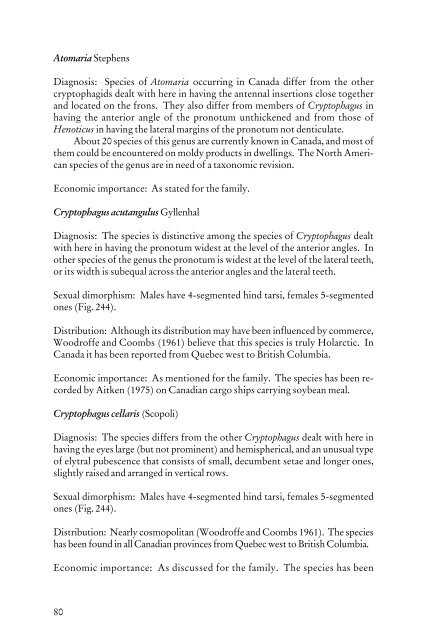Beetles Identification Guide
Beetles Identification Guide
Beetles Identification Guide
Create successful ePaper yourself
Turn your PDF publications into a flip-book with our unique Google optimized e-Paper software.
Atomaria Stephens<br />
Diagnosis: Species of Atomaria occurring in Canada differ from the other<br />
cryptophagids dealt with here in having the antennal insertions close together<br />
and located on the frons. They also differ from members of Cryptophagus in<br />
having the anterior angle of the pronotum unthickened and from those of<br />
Henoticus in having the lateral margins of the pronotum not denticulate.<br />
About 20 species of this genus are currently known in Canada, and most of<br />
them could be encountered on moldy products in dwellings. The North American<br />
species of the genus are in need of a taxonomic revision.<br />
Economic importance: As stated for the family.<br />
Cryptophagus acutangulus Gyllenhal<br />
Diagnosis: The species is distinctive among the species of Cryptophagus dealt<br />
with here in having the pronotum widest at the level of the anterior angles. In<br />
other species of the genus the pronotum is widest at the level of the lateral teeth,<br />
or its width is subequal across the anterior angles and the lateral teeth.<br />
Sexual dimorphism: Males have 4-segmented hind tarsi, females 5-segmented<br />
ones (Fig. 244).<br />
Distribution: Although its distribution may have been influenced by commerce,<br />
Woodroffe and Coombs (1961) believe that this species is truly Holarctic. In<br />
Canada it has been reported from Quebec west to British Columbia.<br />
Economic importance: As mentioned for the family. The species has been recorded<br />
by Aitken (1975) on Canadian cargo ships carrying soybean meal.<br />
Cryptophagus cellaris (Scopoli)<br />
Diagnosis: The species differs from the other Cryptophagus dealt with here in<br />
having the eyes large (but not prominent) and hemispherical, and an unusual type<br />
of elytral pubescence that consists of small, decumbent setae and longer ones,<br />
slightly raised and arranged in vertical rows.<br />
Sexual dimorphism: Males have 4-segmented hind tarsi, females 5-segmented<br />
ones (Fig. 244).<br />
Distribution: Nearly cosmopolitan (Woodroffe and Coombs 1961). The species<br />
has been found in all Canadian provinces from Quebec west to British Columbia.<br />
Economic importance: As discussed for the family. The species has been<br />
80
















